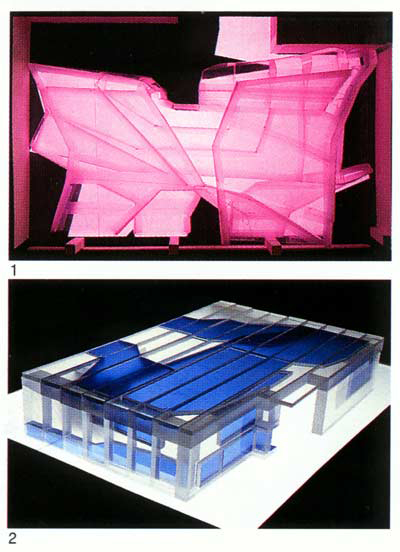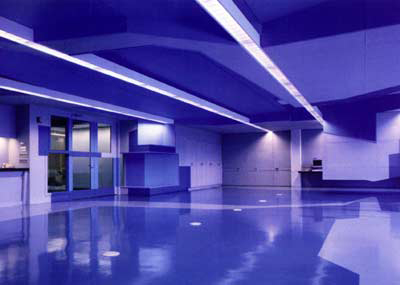Andrew Zago
Andrew Zago has been in professional practice since 1987 first in Los Angeles in the partnerships AKS RUNO and Shirdel Zago Kipnis, and now as principal of Zago Architecture in Detroit. Among his recent projects is the Cornell Synthesis Studio a new design studio facility for Cornell University's College of Engineering. He has taught architecture since 1986 at the Southern California Institute of Architecture (SCI-Arc), at Cornell University where he held a joint position with the School of Mechanical and Aerospace Engineering, and most recently at the University of Michigan. A native of Detroit, Mr. Zago received his Bachelor of Fine Art from the University of Michigan and his Master of Architecture from Harvard University. His work has been published widely in such journals as Architecture+Urbanism, l'Arca, and Werk Bauen+Wohnen. He has lectured and exhibited his work in the U. S., Europe, and Asia.

Zago Architecture, Professional Statement:
A concern of mine is the current condition and future development of the profession of architecture. As has been widely noted there is a diminution in the value ascribed and role given to the profession by the public. Coupled to this I see an inability on the part of conscientious and creative American practitioners to forge a relevant new direction for the profession. I believe there is little practical difference between problems of the structure of the profession and problems of space and design. The paralysis found on both fronts stem from the same root problems - the two must be addressed in concert. If architects can radically reformulate their model of space - as both a matter of design and of professional engagement - new potentials may emerge. Pragmatically, it may lead to an alignment of architecture with an economy that reinvents its structure yet still has not found the space of that transformation.
Architecture must transform its structure in order to attain an originally role as manifesto of unconscious spatial imaginings. Not the shape, but the intuition of architecture must radically change. Taken as a new totality, intricately woven into the web of happenstance (particulars), architecture evolves a new kinesthetic sense. This sense presupposes a rejection of formalism, that codified system for disguising architecture as the language of shape-making. It embraces the dissolution of institutions and the emergence of the particular with all its awful stirrings. Architecture addresses the human anima through its own devices, but seeks its relevant manifestations within the politically charged arena of active life. To transform architecture, transform its practice. Reject the notion of classical space - the sense of designing as though one were adding to Euclid's Elements. If architecture springs from geometry then (at least) come to terms with the contemporary measure of the world. Architecture exists as events. That is, as a series of perceptions in space/time. This has always been so. It is, however, our era that can frame this as an inclusive idea and which has the tools to make it a functioning premise in architecture.

In discussing the current condition of public life, the French philosopher Paul Virilio cites the end of classical space arguing that physical referents no longer define the urban spatial experience. In the field of architecture, classical space forms a convention which permeates every aspect of production from conception to execution. More than an expedient system of documentation and communication, this convention controls the design process, containing it within fixed spatial parameters.
In other fields critical analysis has shown that the political positioning of a work depends on its structural premise rather than on its stated intentions or outward appearance. Conversely, focusing only on its explicit theme allows the structural premise to operate unchallenged. Architecture finds itself in the cultural and social margins because it has been unable to confront and transform its outdated spatial premise. The characteristics of this premise include the definition of objective boundaries separating object and void, a durability in time and the operation of a regular projective geometry predicated on a stable and homogeneous plenum.
Beyond the pragmatics, architecture can't be thought of as necessary until it is first awful. Certainly in my country, architecture has reached a plateau because America has reached the end of its originating spatial intuition. Architecture cannot transcend that plateau until we can demonstrate space as an adult sensation. What was once an easy, thrilling, unselfconscious spatial impulse - American Space - has mutated to create our paedomorphic landscape. The spatial intuition that has fueled America must be overturned. This is an urban potential. It is not entertainment but frank encounter. We architects share a professional and ethical responsibility to articulate the essential humanity of and necessity for space - space as a product of creative imagination. To function, now politically, as a catalyst for a new awareness of space. To transmute public imagination and foster a passion for new potential. By what measure can we be architects if we do not believe in, and publicly advocate the necessity of our art?
Zago Architecture, Firm Philosophy:
My firm's design philosophy is to create architecture as a synergistic environment that brings together a building's design composition, its patterns of use, and its relation to its surroundings. Augmenting this philosophy is a working method that emphasizes collaboration. In recent years, architects have developed sophisticated compositional approaches to building design, allowing buildings to take on a greater public presence, to assert themselves more positively in the built environment. At the same time, other developments have increased an awareness of a building's context - natural and man made. What remains to be achieved is a synthesis of a building's form, its setting, and the dynamics of its use into an overall environment. In this synthesis, the various components and features of a project harmonize to create an experience that enhances the performance of a building and increases its user's interest. My firm works to pursue this new synergy. I engage a new definition of design that is broad and inclusive. I embrace a progressive vision of architecture that reflects also my client's increasingly dynamic needs.
While a building's shape is just one quality among many, it does provide the crucial orienting tool. Over and above its potential for spatial problem solving, architecture's strength is its ability to synthesize an environment. My architectural goal is to make the medium of the environment perceptible; to establish participation with architecture as a spatial engagement.
My approach to architecture aligns with current innovations in business and manufacturing theory. Rigid organizational hierarchies and classical production models have proved ill-suited to the complexities of today. There is an unprecedented grate of technological innovation, a shift away from monolithic manufacturing methods, the related rise of niche markets and their demands of permanent innovation and quality improvement, increased pace for survival in the marketplace, emphasis on quality, and the globalization of marketplaces. These have transformed our business and social environment; to respond in design to these transformations, problems require flexible, creative approaches - strategies that develop from the dynamics of the problem itself. My firm is organized in response.
Three projects illustrate this philosophy: the Detroit Science Center Expansion and Renovation addresses the varied nature of its context through inclusion; the Cornell Synthesis Studio creates an environment for interaction through the arrangement of function and dynamic form; the Kansai National Diet Library evokes a sense of flow - natural and electronic - through the geometry of its plans.
The project credits are:
PROJECT:
Dean L. Taylor Design Studio
Sibley School of Mechanical and Aerospace Engineering
Cornell University
Ithaca, New York 1995 ·
Client and Design Consultant: Professor Dean L. Taylor
· Design Architect: Zago Architecture, Detroit, Michigan
· Principal in Charge: Andrew Zago, AIA · Project Designer: Richard Scott
· Design Team: Roland Flores, Jose Gutierrez, Alice Hsu, Darin Jellison,
Clover Lee
· Project Assistants: Christopher Ho, Eric Howeler, David Prada
· Executive Architect: Cornell Planning Design and Construction
· Project Architects: Gary Wilhelm, Chad Hoover
· Mechanical Consultant: Randy Lacey · Shop Consultant: Art Stern
PROJECT:
The Shape of Flow: Project for the National Diet Library
Kansai Science City, Japan 1996
· Project Architect: Andrew Zago, AIA · Project Designer: Han D. Suh
· Design team: Nattaya Chaiwanakupt, Rita Hill, Hina N. Jamelle, Byungkoo
Lee, Ung-Joo Scott Lee, Sarayut Supsook, Daniel Tsao
· Special Consultant: Prof. James Dearing, Michigan State University
PROJECT: The Detroit Science Center, Expansion and Renovation Detroit
Science Center
Detroit, Michigan 1998
· Project Architect: Andrew Zago, AIA
· Project Assistant: Peter Magoulick